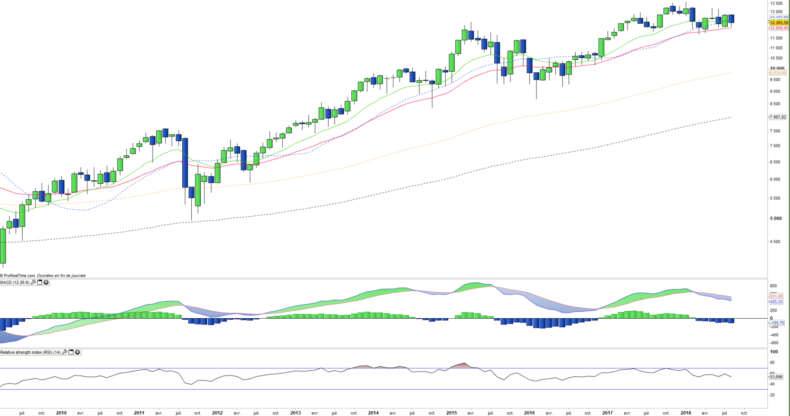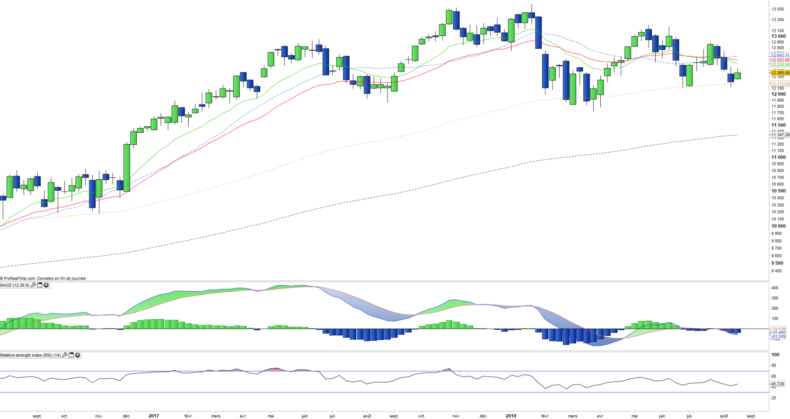Lyxor DAX - DAX - 24/08/2018
Short Term strategy: Negative (0%) / Trend -
Long Term strategy: Neutral (50%) / Trend -
pour accéder à nos achats / ventes sur les indices
Characteristics of the ETF
The DAX ETF (Lyxor), quoted in Euro, replicates the DAX 30 index which is composed of the 30 largest listed German securities, representative of the main sectors of the economy, while the stocks are selected according to the importance of their market capitalization.
The costs of this ETF are low at 0.15% and AUM is quite high at 930M €, which makes it a good vehicle in terms of costs / liquidity. The replication method is direct (physical) and the dividend distribution is capitalized.
Alternative ETFS: DBXD (DB-x Tracker in Euro), DAXEX (Ishares in Euro)
Index & components
The top 10 stocks are mainly large industrial stocks such as Siemens or Bayer, while there are only 3 financial stocks: Allianz, Commerzbank and Deutsche Bank, the German master index is relatively small and mostly composed of large industrial groups.
Unlike the English, French or Italian indices, the DAX is also distinguished by the absence of large oil companies that weigh heavily in the weighting of the CAC40, FTSE100 or FTSEMIB40, which is double-edged according to the cycle specific to energy sector. In addition, the financials weigh only 16% of the index, half for the insurance giant Allianz, so the banking sector has a low weight reflected in the well-known weakness of Deutsche Bank and Commerzbank. Conversely, the automotive and chemical sectors are heavier than the other European indices, while the technology sector is mainly represented by SAP (10%) whose market capitalization exceeds € 100 billion.
In summary, the DAX is a fairly strong index from a sectoral point of view which can make it evolve differently from other European indices. German fundamentals are very solid (GDP growth above 2%, historically low unemployment rate at 5.5% and accelerated deleveraging up to 2020).
The main risks concern Germany's main customers, namely the United Kingdom, which could suffer from Brexit, the US in political uncertainty and threatening it with a trade war, Russia which remains a difficult and aggressive neighbor and China because of its commercial practices which also tend to limit access to its domestic market to Western industrialists, particularly in the automotive and technology sectors.
Latest developments
After an increase of 6.9% in 2016, the DAX30 grew by 12.5% in 2017, more than the stoxx600 (+ 10.6%). But the index has fallen by 4.3% since the beginning of the year, which is a lower performance than Stoxx600NR (+ 1%), which is mainly related to the risks of trade war with the US, and fears about Turkey.
The German economy is based on exports and has everything to lose in a trade war and the general increase of tariffs. The tariff increases on the European automotive sector are suspended until further notice by the US, but no agreement has yet been reached between Europe and the US which feeds the uncertainties. The sector, which accounts for 10% of the index is also under pressure after the profit warning of Continental which feeds doubts on the cycle.
The financial crisis that is developing in Turkey could have repercussions on the German economy, which has a lot of interests in the country and a large community.
Monthly data
On the weekly chart, we can observe a trend that remains bullish so far, even if the momentum has been running out of steam for the last few months, which has had the effect of triggering a bearish reversal of the MACD, also visible on the RSI and the Momentum indicator. However moving averages remain upward and the EMA26 plays its role of resistance. The long-term trend remains bullish anyway.
Données hebdomadaires
The weekly chart shows a more contrasting situation. The medium-term trend is deteriorating, but the support provided by the EMA100 holds for the moment. The breakout of this support would significantly degrade the technical configuration of the index with a very short-term objective on the EMA200 8% lower. In addition, a shoulder head structure would be confirmed in the event of a failure of the support of 12000 pts which corresponds to the EMA100 level.
ETF Objective
DAX is a UCITS ETF, listed in EUR, which seeks to replicate the DAX index (30 german companies)
Characteristics
| Inception date | 01/06/2006 |
| Expense ratio | 0,15% |
| Issuer | Lyxor |
| Benchmark | Indice DAX 30 |
| Code/Ticker | DAX |
| ISIN | LU0252633754 |
| UCITS | Yes |
| Currency | € |
| Exchange | Euronext |
| Assets Under Management | 930 M€ |
| Replication method | Direct (Physical) |
| PEA (France) | Yes |
| SRD (France) | Yes |
| Dividend | Capitalization |
| Currency Risk | No |
| Number of Holdings | 30 |
| Risk | 3/5 |
Country Breakdown
| Germany | 100% |
Sector Breakdown
| Consumer discretionary | 16% |
| Financials | 16% |
| Materials | 15% |
| Industrials | 14% |
| Health Care | 13% |
| Information Technology | 13% |
| Telecom | 5% |
| Others | 9% |
Top Ten Holdings
| SAP | 10% |
| Siemens | 9% |
| Allianz | 8% |
| BASF | 8% |
| Bayer | 7% |
| Daimler | 5% |
| Deutsche Telekom | 5% |
| Adidas | 4% |
| Linde | 3% |
| Deutsche Post | 3% |


